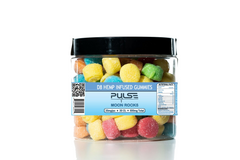CBD 7/29/2016
CBD: Everything You Need To Know About Cannabidiol
- Anna Wilcox
-
 0
0
- 26 July, 2016
- Cannabis
The CBD movement
Before she was five years old, Charlotte Figi stopped laughing.
While the average child laughs around 300 times a day, Charlotte temporarily lost her ability to communicate. She has a rare and severe form of epilepsy, Dravet syndrome.
Dravet syndrome affects roughly 1 in 30,000 infants around the globe. Though most Dravet patients begin their lives as healthy children, development quickly begins to regress after the first few months. Intense seizures overtake children as young as three months old. These seizures cause them to lose consciousness and convulse for up to a few hours at a time.
The Figi’s were desperate to find relief for their daughter after years of rushed trips to the ER. The dealt with complications from experimental medications and being told that they’ve reached “the end of the line”. They finally made the decision that would ultimately spur a movement and, more importantly, bring their daughter back to life.
The Figi’s decided to treat their daughter with cannabidiol (CBD), one of the primary compounds found in the marijuana plant.
What is cannabidiol (CBD)?
The endocannabinoid system is a vast network of cell receptor proteins with many functions. Certain receptors are heavily concentrated in the central nervous system. But, others are found all over the body. They’re in your skin, digestive tract, and even in your reproductive organs. The endocannabinoid system helps control everything from mood, cognition, movement, appetite, immune response, sleep, ovulation, and sperm development.
The human body produces compounds similar to those in the cannabis plant, called endocannabinoids. Molecules found on the herb are technically called phytocannabinoids. Like CBD’s more famous relative, tetrahydrocannabinol (THC), cannabidiol is just one of 85+ phytocannabinoids found in the marijuana plant. Very unlike THC, however, CBD is non-psychoactive.
Yep, that’s right. CBD cannot get you “high” or “stoned” in the way that THC does. While CBD still has an effect on your body, consuming CBD by itself isn’t going to send you on the cerebral adventure associated with THC. For decades, medical professionals and the general public overlooked CBD because marijuana’s psychoactive effects took center stage.
CBD: Underappreciated for too long
The competition is tough. After nearly three decades of rising demands for psychoactive, it’s not uncommon to walk into a dispensary today and find cannabis with THC content over 20%. Focusing on THC content alone meant growers selectively began to eliminate overlooked CBD from the mixture, making access nearly impossible for anyone hoping to experiment with CBD as medicine.
Fortunately for children like Charlotte, one Colorado family was ahead of the curve. The Stanley Brothers had been developing exactly the plant the Figi’s had been searching for: a strain high in CBD and low in THC.
Before making the final decision to try CBD as a treatment, Charlotte was having 300 grand mal seizures a week, one every 15 minutes.
After adding CBD oil to her daily routine? CBD kept Charlotte’s seizures at bay for an entire week.
The Figi’s were astonished. Paige Figi tells reporters:
I didn’t hear her laugh for six months. I didn’t hear her voice at all, just her crying. I can’t imagine that I would be watching her making these gains that she’s making, doing the things that she’s doing (without the medical marijuana). I don’t take it for granted. Every day is a blessing.
CNN first aired Charlotte’s story in 2013. Since then, CBD has been making headlines all over the world. Families began relocating to Denver to find medical cannabis for their sick children. Even states that once seemed centuries away from changing their cannabis policy began to introduce pro-CBD legislative initiatives.
Now, high-CBD strains can be found at nearly every medical cannabis dispensary in medical states. All thanks to the Stanley Brothers and the Figis for sharing their incredible story.
How does CBD work?
One reason why figuring out all of the ways CBD actually works is so difficult is because it’s polypharmacological, meaning that it affects more than one aspect of our bodies at a time. In a 2013 article, authors Srinivas Reddy and Shuexing Zhang summarize that:
Polypharmacology remains to be one of the major challenges in drug development, and it opens novel avenues to rationally design next generation of more effective but less toxic therapeutic agents. – Reddy and Zhang
Simply stated, when a drug causes bodily changes on multiple different levels, it’s difficult for us to figure out exactly how these changes interact with each other. So, while we now know quite a bit about CBD, the bottom of the iceberg still awaits discovery.
The science behind CBD
THC specifically binds to the CB1 and CB2 cannabinoid receptors on your cells. CBD doesn’t bind to these receptors very well. It prefers to do something a little different. This is where things get complicated. Researchers have discovered a few ways that CBD interacts with the body, but this area of research is still fairly young. New discoveries are made each year.
Here’s a simple summary of what we currently know about CBD. The cannabinoid activates receptorssuch as vanilloid, adenosine, and serotonin receptors. Vanilloid receptors help mediate pain signals in the body. Adenosine receptors help determine your sleep-wake cycle. Caffeine, by comparison, blocks adenosine and creates a feeling of alertness. Serotonin receptors help control mood.
CBD also regulates the endocannabinoids that occur naturally in your body. It blocks a particular fatty acid known as fatty-acid amide hydrolase (FAAH). This enzyme that’s responsible for breaking down the naturally occurring endocannabinoid anandamide in your body.
Anandamide helps regulate basic functions like pleasure and reward, appetite, ovulation, memory, sleep, and pain. With nothing to break anandamide into smaller parts, CBD boosts the amount of this chemical in your system.
But that’s not all. Cannabidiol has been shown to engage with receptors that help modulate body temperature and immune function, reducing inflammation. So, it does quite a lot of different things.
CBD vs THC
Consuming CBD actually blocks some of your brain’s CB1 receptors, meaning that THC cannot have an effect on them.
Another interesting difference between the two cannabinoids is their effect on metabolism. You’ve probably already heard of the munchies. THC is to blame for all of those late night snacks after consuming a little cannabis. CBD actually has the opposite effect. Studies have shown that CBD decreases appetite and increases satiety.
What is CBD used to treat?
However, below is a short list of some other conditions that CBD can help. For more information on these conditions, please click the links to the associated articles.
Conditions responsive to CBD:
- Cancer
- Diabetes
- Lupus
- Motor disorders
- Nicotine addiction
- Parkinson’s Disease
- Chronic and neuropathic pain
- Obsessive Compulsive Disorder
- Osteoporosis
- Various pediatric conditions
3 major conditions helped by CBD
1. Epileptic Disorders
As the anecdote about Charlotte Figi has hopefully made clear, the endocannabinoid system may play a key role in the future treatment of epilepsy.
One way CBD reduces seizures is through its mediation of a neurotransmitter called GABA. This neurotransmitter has calming effects, it dampens excitability in the brain. When GABA levels drop too low, you’re likely to have a seizure. CBD is a GABA uptake inhibitor, meaning that it creates a surplus of GABA in the brain.
Both THC and CBD inhibit synaptic transmission, or changes the way that neurons in your brain release and absorb other chemicals. CBD has also been found to help increase the efficacy of other common anti-epileptic drugs and is known to be neuroprotective. It helps keep brain cells healthy and reduces cell damage.
GABAs role in seizures only represents a small piece of epilepsy’s complicated puzzle. More research needs to to be done to test CBD’s efficacy in various types of epilepsy. As we learn more, additional mechanisms of action are sure to be discovered.
2. Schizophrenia and Psychotic Disorders
THC affects brain regions like the hippocampus and prefrontal cortex, leading to its psychoactive effect. These are the same brain regions that are affected by schizophrenia. CBD, however, has the exactopposite effect of THC on these exact same regions, causing many researchers to label CBD as anti-psychotic.
Coupled with traditional medication, early trials with CBD as a supplemental treatment for schizophrenia were successful with an impressive safety profile. The potent anti-inflammatory properties of CBD may also lend to its anti-psychotic properties. Psychosis has been linked to increased inflammation in the brain.
3. Depression and Anxiety
CBD’s relationship to anandamide may play a big role in helping us understand anxiety in the future. According to a recently published New York Times editorial, patients feel less anxious when they have more anandamide in the body. Because CBD inhibits the enzyme that breaks down anandamide, it allows you to have more of this feel-good chemical floating around in your body at any given time.
CBD’s ability to increase feel-good compounds in your body make it extremely effective against depressionand anxiety. It creates a calm, subdued, pleasant sensation that lets you go about your day without a psychoactive high. Arguably, CBD is more effective at managing a wide range of mental health conditions.
THC works well for some people, but CBD provides the same results without the risk of increased anxiety.
Whole plant medicine
The entourage effect is the idea that combinations of cannabinoids, like CBD and THC, work together in synergy to produce certain therapeutic effects in the body. This may explain why some epileptic patients respond well to CBD, while others respond better to THC. The entourage effect has already been used in pharmaceutical medicines. GW Pharmaceuticals’ Multiple Sclerosis (MS) drug
GW Pharmaceuticals’ Multiple Sclerosis (MS) drug Sativex, for example, contains a balanced ratio of THC to CBD. The two cannabinoids together work better at managing MS symptoms than just CBD alone.
High CBD strains
Keep in mind that when you buy high-CBD flower, that doesn’t necessarily mean it’s THC-free. Many strains advertised as high-CBD still contain some psychoactive cannabinoids. So, if you’re looking to avoid psychoactives, be sure to ask your budtender or supplier for further testing information about the particular strain.
Other sources of CBD:
- Coconut Oil
- Oil
- Capsules –Note: You can extract CBD at home the way you would when cooking with THC.
If CBD is non-psychoactive, is it still illegal?
To provide everyone with safe, easy access to CBD, it needs to be legalized. CBD has a wide variety of medical benefits and lack of addictive potential, all plant cannabinoids fall under the same Schedule 1 Drug classification. Until this plant is either reclassified or legalized, the harsh federal restrictions on cannabis prevent adequate research on the impacts and health benefits of CBD and marijuana use.
If there’s one point to bring home in this article, it’s this: CBD has tremendous therapeutic potential. But, we need more hard-hitting research. Already, the discovery of THC and the endocannabinoid systemhas opened major doors in biochemical and psychiatric medicine. Until we address the legal and political barriers that prevent us from exploring cannabis as medicine, our opened doors will remain unexplored.
How has CBD helped you? Share your story with us on social media or in the comments below. We’d love to hear from you.



